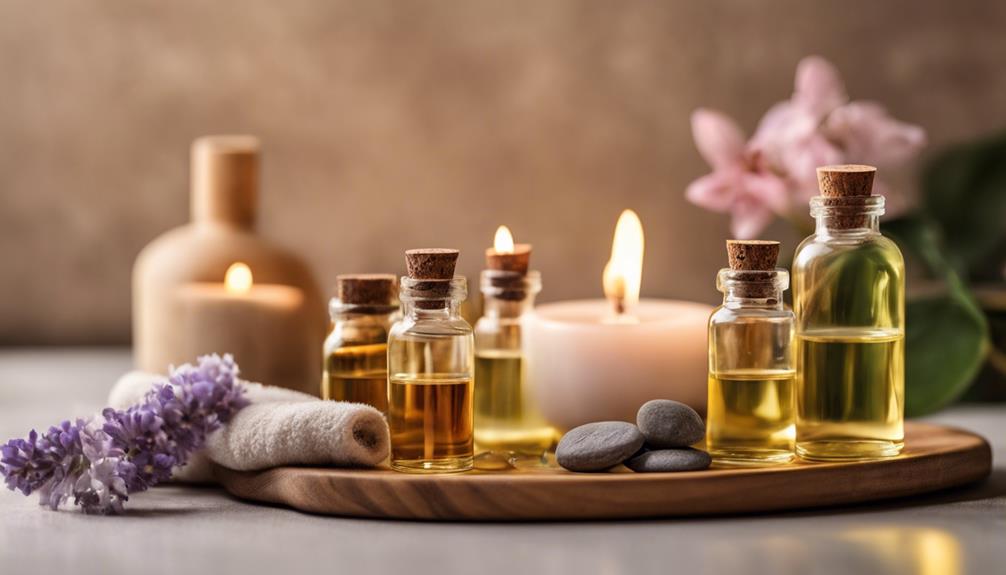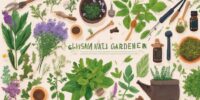The Complete Guide to Aromatherapy by Salvatore Battaglia – Summary and Review

'The Complete Guide to Aromatherapy' by Salvatore Battaglia is a comprehensive resource on essential oils. It covers a range of topics including the history of aromatherapy, the benefits of different essential oils, practical applications for everyday use, blending techniques to create custom scents, and safety precautions to consider.
It serves as a beacon of knowledge in the field of aromatherapy, offering a treasure trove of aromatic secrets waiting to be discovered by enthusiasts and practitioners alike.
Key Takeaways
- Essential oils offer holistic benefits for body, mind, and spirit.
- Aromatherapy blends tradition with modern science effectively.
- Safety precautions like dilution and patch tests ensure proper usage.
- Personalized aromatherapy experiences enhance well-being and complement traditional treatments.
Background and Introduction
In exploring the world of aromatherapy, one must first immerse into the rich tapestry of its background and introduction. Aromatherapy, dating back centuries, finds its roots in the use of essential oils derived from plants. These oils are the very essence of nature's healing properties, carefully extracted to harness their therapeutic benefits. The introduction to essential oils marks the beginning of a journey towards holistic well-being and harmony.
The benefits of aromatherapy are vast and profound. From promoting relaxation and reducing stress to enhancing mental clarity and boosting energy levels, the therapeutic effects of essential oils are both powerful and versatile. Aromatherapy not only nurtures the body but also nurtures the mind and spirit, offering a holistic approach to health and wellness.
As individuals embrace the world of aromatherapy, they open themselves to a domain where nature's gifts are celebrated and utilized for their transformative properties. The introduction to essential oils is the gateway to a world where healing and rejuvenation flourish, offering a path to a more balanced and vibrant life.
History and Evolution
Emanating from ancient practices and traditions, the history and evolution of aromatherapy disclose an enthralling story of nature's enduring influence on human well-being. Through the centuries, aromatherapy has woven a tapestry of healing that resonates with the essence of life itself.
Investigate into the past, and you'll find a journey marked by:
- Evolutionary Origins: Aromatherapy traces its roots back to ancient civilizations like Egypt, China, and India, where aromatic substances were revered for their medicinal and spiritual properties.
- Historical Developments: The art of using essential oils for therapeutic purposes flourished during the Middle Ages in Europe, as alchemists and herbalists honed their craft.
- Cultural Significance: Aromatherapy's significance transcended borders, influencing diverse cultures and belief systems across the globe.
- Revival in Modern Times: The 20th century witnessed a resurgence of interest in aromatherapy, leading to scientific exploration and widespread adoption.
- Integration with Holistic Practices: Today, aromatherapy seamlessly integrates with holistic wellness approaches, embodying a harmonious blend of tradition and modernity.
Science and Benefits
Within the domain of aromatherapy lies a fascinating interplay of science and benefits waiting to be explored.
The intricate mechanisms behind the effects of aromas are illuminated, shedding light on the therapeutic potential they hold.
Revealing these nuances not only enhances understanding but also paves the way for harnessing the healing powers of scents.
Aroma Science Explained
With a deep understanding of aroma science, one can unravel the profound benefits that aromatherapy offers to both the mind and body. Aroma molecules are the essence of essential oils, carrying within them the power to evoke emotions, soothe the soul, and invigorate the spirit. Through the intricate dance of these volatile compounds, essential oils interact with our olfactory system and trigger responses that go beyond mere scent.
The science behind aromatherapy reveals a world where molecules hold the key to releasing relaxation, focus, and even healing. Delving into this aromatic domain allows individuals to tap into the therapeutic potential of plants and harness their natural properties for holistic well-being.
- Aroma molecules are the building blocks of essential oils.
- Essential oils interact with the olfactory system to evoke responses.
- These molecules have the power to induce relaxation and focus.
- Understanding aroma science releases the therapeutic potential of plants.
- Aromatherapy offers holistic benefits for the mind and body.
Therapeutic Benefits Unveiled
Revealing the therapeutic benefits of aromatherapy illuminates the profound impact that essential oils can have on both the mind and body, offering a gateway to holistic well-being through the natural properties of plants.
Health benefits attributed to essential oils encompass a wide array of physical and mental advantages, ranging from alleviating stress and anxiety to promoting relaxation and enhancing focus. These potent plant extracts have been harnessed for centuries to aid in various ailments, showcasing their versatile healing capabilities.
By harnessing the power of essential oils, individuals can tap into a natural and gentle approach to wellness, enabling freedom from synthetic substances and embracing the purity of botanical remedies.
The therapeutic potential of essential oils extends beyond mere fragrance, delving deep into the vital health and energy.
Practical Applications
When considering the practical applications of aromatherapy, one must carefully assess the specific essential oils and their corresponding benefits for best utilization. Aromatherapy practices can be truly transformative when applied with intention and understanding.
Here are five key ways to incorporate essential oils into your daily life:
- Diffusion: Utilize a diffuser to disperse essential oils throughout a room, creating a calming or invigorating atmosphere.
- Topical Application: Dilute essential oils with a carrier oil for safe application on the skin, targeting specific areas for relief or relaxation.
- Inhalation: Add a few drops of essential oil to a bowl of hot water for inhalation, aiding respiratory issues or promoting mental clarity.
- Massage: Blend essential oils into a carrier oil for a soothing massage experience, easing muscle tension and enhancing relaxation.
- Personal Care: Incorporate essential oils into your beauty and self-care routine, creating natural perfumes, skincare products, and hair treatments tailored to your needs.
Blending Techniques
Exploring the art of blending techniques in aromatherapy reveals the intricate harmony of combining different essential oils to create potent and purposeful aromatic blends. Essential oil pairings are at the heart of creating enchanting aromas that can evoke various emotions and promote well-being. A skilled aromatherapist understands the nuances of each oil and how they can work together to enhance the overall therapeutic effect. By mastering aromatic synergy techniques, practitioners can reveal the full potential of each oil and create harmonious blends that address specific needs.
Below is a table showcasing some common essential oil pairings to inspire your blending journey:
| Essential Oil 1 | Essential Oil 2 |
|---|---|
| Lavender | Peppermint |
| Eucalyptus | Lemon |
| Bergamot | Frankincense |
| Tea Tree | Rosemary |
| Ylang Ylang | Geranium |
Safety Precautions
Implementing safety precautions is paramount in the practice of aromatherapy to secure the well-being of both the practitioner and the recipient. When working with essential oils, it's essential to contemplate the following:
- Dilution: Essential oils are highly concentrated and should be diluted before applying to the skin to prevent irritation or sensitization.
- Patch Testing: Conducting a patch test on a small area of skin helps determine any potential allergic reactions before widespread use.
- Phototoxicity: Certain oils can cause skin sensitivity when exposed to sunlight, so caution must be exercised when using them.
- Pregnancy: Pregnant individuals should consult a qualified aromatherapist before using essential oils due to the potential impact on the developing fetus.
- Storage: Properly storing essential oils in dark glass bottles away from direct sunlight and heat helps maintain their potency and quality.
Review and Recommendation
In evaluating the content of aromatherapy practices, it becomes evident that a thorough evaluation is essential to determine its efficacy.
Practical application suggestions play an important role in guiding individuals towards incorporating aromatherapy into their daily routines effectively.
Evaluation of Content
Upon thorough examination of the content, it becomes evident that a thorough review and thoughtful recommendation are essential components for evaluating the efficacy of aromatherapy. Critical analysis and comparative study play an important role in evaluating the depth and breadth of the information presented in the guide. To evaluate the content effectively, one should consider:
- The scientific validity of aromatherapy practices
- The practical applicability of techniques
- The historical context of essential oils
- The safety precautions recommended for different methods of use
- The holistic approach to well-being advocated throughout the guide.
These components are crucial for a comprehensive assessment of the effectiveness and reliability of the information provided in the aromatherapy guide.
Practical Application Suggestions
With a keen focus on practicality and effectiveness, one must consider the application suggestions for aromatherapy that align with individual needs and preferences. Essential oil combinations play an important role in creating personalized aromatherapy experiences. By blending different oils, one can harness a variety of benefits such as relaxation, focus, or even invigoration.
Exploring aromatherapy recipes can open up a world of possibilities. These recipes, whether for diffusing, massage oils, or bath blends, can cater to specific needs like stress relief, respiratory support, or mood enhancement. The beauty of aromatherapy lies in its versatility and adaptability to suit each person's unique requirements.
Frequently Asked Questions
Can Aromatherapy Be Used as a Substitute for Medical Treatment?
Aromatherapy can be a beneficial alternative therapy, but it's important to remember that safety precautions must be taken. While it can complement medical treatment, it should not be used as a substitute without consulting a healthcare professional.
Are There Any Specific Essential Oils That Should Be Avoided During Pregnancy?
During pregnancy, safety is paramount when using essential oils. Some oils, like cinnamon, rosemary, and clary sage, should be avoided due to potential risks. Taking precautions and consulting with a healthcare provider guarantees a healthy experience.
How Long Does It Typically Take to See Results From Aromatherapy Treatments?
Aromatherapy can offer immediate effects, providing short term relief. Over time, the treatments can lead to long term benefits with lasting impact. Results vary, but many people experience improvements within a few sessions.
Can Essential Oils Be Ingested for Therapeutic Purposes?
Ingesting essential oils for therapeutic benefits can be risky without proper guidance. Always consult a qualified aromatherapist or healthcare provider before internal use. Safety is paramount in harnessing the power of essential oils.
Are There Any Potential Side Effects or Risks Associated With Using Essential Oils for Aromatherapy?
When using essential oils for aromatherapy, it's crucial to take into account potential precautions. Risks involved may include skin irritation, allergic reactions, and sensitivities. Safety concerns should be addressed by conducting a patch test and consulting with a healthcare professional.











